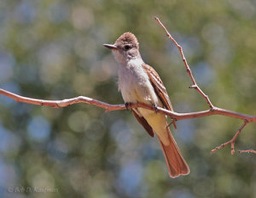Without any particular destination agreed upon, we woke up a little late on Monday. But then the birding itch continuosly pestered our subconscious. "How about we go the mountains (referring to the San Gabriels towering some 7000 feet above us)?" I suggested. My wife agreed. Driving on the freeway I realized I didn't have the $5 needed for the Forest Pass - this is required if one is to park at any of the camp/nature sites there. "Why don't we go to Placerita Canyon instead?" Cynthia asked. I thought it was a good idea, so we did.
Soon after parking we immediately saw an American Kestrel perched on a leafless tree.
Suddenly, my wife asked me to be quiet as she tried to locate the source of a bird call nearby. It wasn't long before she was pointing to something yellow among the green leaves of a sycamore tree. It was a Hooded Oriole - the first one we've seen this year. Unfortunately, it was spooked by something and flew off before we could even get some decent shots of it. Not far from where the oriole was, a Black-chinned Hummingbird was preening in the morning sun.
We hit the trails at the back of the nature center where Cynthia played hide and seek with a Spotted Towhee.
The place was also alive with various kinds of flycatchers. A particular group of flycatchers known to scientists as the Genus Empidonax has always been a bane to birdwatchers including the more seasoned ones, because these birds all look very similar to each other. "Those darn empids" has been a common expression of exasperation among birders. And those darn empids were giving us a hard time here at Placerita Canyon. But I think I got one ID correct - the Hammond's Flycatcher - a lifer for us. Maybe. Hopefully.
Update: 5/28/08 - The photo below turned out NOT to be a Hammond's after all. It was a Western Wood-Pewee which was not a lifer. Oh, darn!
Black-headed Grosbeaks were quite plentiful and at the picnic grounds, Oak Titmice, White-breasted Nuthatches, Nuttall's Woodpeckers and Western Bluebirds were all hunting for food in their own unique way. It was almost noon so we headed back to the Jeep. It was then that another Hooded Oriole decided to pose for us. Cynthia and I probably took about 50 shots each as the cooperative bird just stayed in the tree in front of us.
We were both so happy with our luck that Cynthia decided to push it and suggested we go to the place where the Spotted Owl hangs out. I looked at her half amused and half in disbelief as it was now past noon and we only had some chocolate candies for a snack. But it 's not always that I get this encouragement from her, so off we went, all the while explaining to her that the hike is a bit strenuous.
She went through the long walk gamely and when we arrived at the spot, there were already people in there. The male owl was easy to find as it was snoozing directly above the trail.
Despite the noise made by the hikers (only a couple were birders) he just slept like there's no care in the world. Soon it became apparent that this place is a popular destination on weekends and holidays. Wave upon wave of hikers, most of them with dogs (!!!) and toddlers, dropped by totally unaware of the avian celebrity above them. It was only when they notice us craning our necks and pointing our cameras upwards that they noticed the bird.
Sidenote: Cynthia and I looked at each other sheepishly as we watched toddlers, some probably as young as 1 year old negotiate the (for us - seemingly long and arduous) hike with such ease.
Several feet away on a different tree and on a higher branch, a baby owl was snoozing as well. Suddenly I saw the mama owl fly in bringing something in her talons. Cynthia and I scooted over to where they are and positioned ourselves to get better views (and photos) of mama spotted owl feeding her baby with a freshly caught rat. I filled out 1G of my flash card trying to get a decent photograph.
More people were coming in and it was already past 1 pm so we reluctantly left the scene. On the way back, Cynthia got a great shot of an American Robin
while I got a Steller's Jay.
It was a long, exhausting birding day for us and we slept like the papa owl that night.












.jpg)
.jpg)










